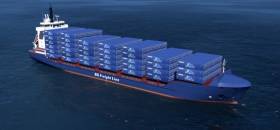Displaying items by tag: 'Ireland' Max
#IrelandMax- Afloat has further researched into the names of BG Freight Line’s newbuilds lo-lo ships under construction in China and can reveal BG Emerald is among them, writes Jehan Ashmore.
The custom-built ‘Ireland’ Max containership with ‘green’ credentials is one of a quartet under construction at the Zhoushan Changhong International Shipyard in the city located near the Shanghai Yangshan Harbour. They are expected to enter service in 2018 on BG Freight Line’s short-sea Irish hub feeder services linking the UK, Belgium and the Netherlands.
Newbuild BG Emerald with a 1,004 TEU capacity will also enter the new and first ever Liverpool-Cork containeship service. The Merseyside-River Lee route was launched intially in March by Thea II, which appeared on 'Rivers with Jeremy Paxman'. The TV series broadcast earlier this year showed the presenter on board the 340 TEU boxboat when operating on the Manchester Ship Canal.
Afloat has also indentified the names to be given of the remaining quartet of sisters. They are BG Diamond, Jade and Sapphire.
Also ascertained is that each containership is around 11,000 gross tonnage and that they have been developed by BG Freight Line, in conjunction with designers CIMC ORIC and Arkon Shipping.
The ‘Ireland’ Max containerships are being built to DNV GL specification and fitted with state-of-the-art features in order to comply with Emission Control Area (ECA) requirements. This been a clear commitment by the operators to achieving the highest possible environmental standards.
Each of the quartet will be fitted with a modern wet scrubber system for exhaust cleaning in order to fulfil the requirements for trading within the ECA area. The vessels are also fully fitted for the loading of 45ft short-sea containers in all positions, with room in total for 488 units.
Additionally, a various number of odd-sized containers can be stowed fast and securely due to a new proprietary and innovative cargo stowage system. To minimise operational cost the vessel will be fitted with a modern two-stroke main engine with very low fuel consumption.
Specifications of the new 'Ireland' Max containerships
Containers: 1004 TEU (alternative 488 units 45ft)
Deadweight: 13,250 tonnes (on 8.0m draft)
Length overall: 153m
Reefer plugs: 253
Service Speed: 16 knots
Exhaust cleaning by WET-scrubber
As alluded BG Freight Line operate an extensive lo-lo container feeder network operated by 23 vessels among them BG Ireland. The additon of BG Emerald strenghtens the links of the nations served by the shipping line that is a subsidiary of the Peel Ports Group. They are a major operator of ports throughout the UK.






























































